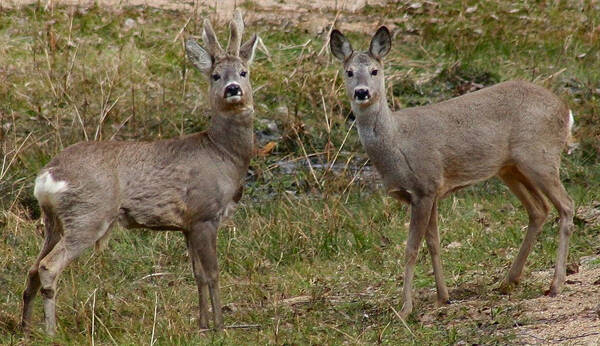Capreolus capreolus
IUCN
LCBasic Information
Scientific classification
- name:Capreolus capreolus
- Scientific Name:western roe deer,Capreolus capreolus,European roe deer
- Outline:Ungulata
- Family:Artiodactyla Cervidae Capreolus
Vital signs
- length:95-135cm
- Weight:15-30kg
- lifetime:About 10 years
Feature
Only male roe deer have horns, which are short and straight.
Distribution and Habitat
It is found throughout Europe, except for some of the extremely cold northernmost islands of Scandinavia, such as Iceland and Ireland.
This deer is a different species from the genus Capreolus, the Eastern roe deer (Capreolus pygargus), which lives in different areas. The Eastern roe deer is found east of the Ural Mountains, as far as Siberia and China. The distribution of the two species meets in the Caucasus Mountains, with the Western roe deer found south of the mountains and the Eastern roe deer found north of the mountains.
Appearance
Small deer, only 95-135 cm long, 65-75 cm high at the shoulder, weighing 15-30 kg. Grey face, reddish body color, reddish-gold in summer, darkening to brown or even black in winter. The abdomen is lighter in color, with a tuft of white hair near the tail. The hair on the tail of female roe deer is heart-shaped, while that of male roe deer is kidney-shaped. The actual tail is very short, only 2-3 cm long, and almost invisible. When frightened, they will scream and raise the white hair on their tail.
Only male roe deer have horns, which are short and straight. In the first two years, the horns are not branched and only reach 5-12 cm. The horns of old and healthy male roe deer can reach 20-25 cm, with two to three branches, and occasionally four branches. Unlike other deer, the horns of Capreolus species begin to grow again immediately after they are lost.
Details
Western roe deer (English: western roe deer, scientific name: Capreolus capreolus), also known as European roe deer, mainly lives in mountains and is rarely seen in plains or islands. There are 5 subspecies.

The western roe deer is often active in the evening. It mainly moves in and out of the forest, but may also go to the grassland or sparsely wooded areas to forage. It mainly feeds on grass, leaves, berries and young branches, and especially likes to eat young grass with high moisture content after rain. The distribution area of the western roe deer is evolving rapidly. In the Neolithic Age, humans began to engage in agriculture and cut down trees to build fields. At that time, a large number of western roe deer came to these new grasslands to look for food.
At the beginning of summer, males began to fight each other for territory. After autumn, the territory is determined, and males use various methods to attract multiple females, which may be screaming loudly or using horns to push away fallen leaves and soil. When female roe deer approach, male roe deer immediately chase, running in circles in an area in an "8" shape, often crushing short shrubs when turning, and their whereabouts are conspicuous, which is called "roe deer circle" by locals.

Wild western roe deer have become extinct in Israel and are being reintroduced. In February 1997, 6 females and 2 males were released, and in 1998, one male and one female were released, and in 1999, 3 more were released. Whether the introduction was successful has not yet been determined.
Listed in the 2008 Red List of Endangered Species of the World Conservation Union (IUCN) ver 3.1 - Low Concern (LC).
Protect wild animals and stop eating game.
Maintaining ecological balance is everyone's responsibility!








